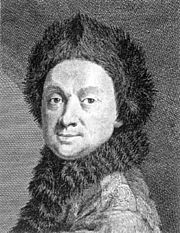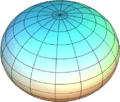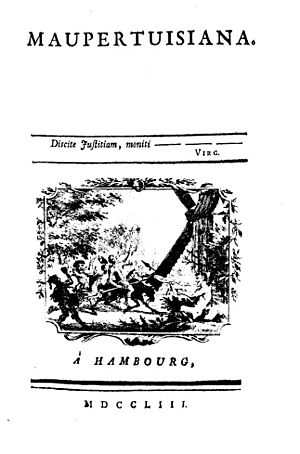Pierre Louis Maupertuis facts for kids
Quick facts for kids
Pierre Louis Maupertuis
|
|
|---|---|

Maupertuis, wearing "lapmudes" from his Lapland expedition. With one hand he is pressing on the globe, making it oblate. Line engraving by J. Daullé, 1741, after R. Levrac-Tournières, 1737.
|
|
| Born | 1698 |
| Died | 27 July 1759 (aged 60) Basel, Switzerland
|
| Known for | Principle of least action, precursor of transmutation |
| Scientific career | |
| Fields | Mathematics, physics, biology, metaphysic, moral philosophy, astronomy, geography |
| Institutions | French Academy, Berlin Academy |
Pierre Louis Moreau de Maupertuis (born 1698 – died 27 July 1759) was an important French scientist. He was a mathematician, a thinker (philosopher), and a writer. He became the leader of the French Academy of Sciences. He was also the first president of the Prussian Academy of Sciences, invited by King Frederick the Great.
Maupertuis traveled to Lapland to help figure out the true shape of Earth. He is famous for creating the principle of least action. This idea helps explain how physical systems move. His work in natural history was also very interesting. He wrote about heredity (how traits are passed down) and the idea of a "struggle for life." These ideas were quite advanced for his time.
Contents
About Maupertuis
Maupertuis was born in Saint-Malo, France, in 1698. His family was quite well-off. His father was involved in many important projects for the king. This helped their family's social and political standing.
Pierre Louis learned mathematics from a private teacher. After finishing his studies, his father helped him join the cavalry. He spent three years there. During this time, he met many important people in society and in mathematics. Then, he moved to Paris to become a famous mathematician and writer. In 1723, he joined the French Academy of Sciences.
Earth's Shape Mystery
In the 1730s, scientists were arguing about the shape of Earth. Maupertuis believed Earth was slightly flattened at the poles, like a squashed ball. This shape is called an oblate spheroid. He based this idea on the work of Isaac Newton.
However, another scientist, Jacques Cassini, thought Earth was stretched out at the poles, like a rugby ball. This shape is called a prolate spheroid.
To solve this argument, King Louis XV sent a special team to Lapland in 1736. Maupertuis led this team, called the French Geodesic Mission. Their job was to measure a part of Earth's surface very carefully.
 |
 |
| Maupertuis's idea: Earth is flattened. |
Cassini's idea: Earth is stretched. |
Maupertuis's measurements proved he was right. Earth is indeed an oblate spheroid. He wrote a book about his trip and his findings. The book also shared stories from his adventure. After this, he became a member of almost all the science groups in Europe.
Principle of Least Action
After his trip to Lapland, Maupertuis worked on a bigger idea. He proposed the principle of least action. This is a deep idea in physics. It suggests that nature always chooses the path that requires the "least action" or effort. This principle helps explain many laws of how things move.
Life in Berlin
In 1740, King Frederick II of Prussia invited Maupertuis to Berlin. Maupertuis even took part in a battle, the Battle of Mollwitz, riding a donkey! He was captured by the Austrians but soon released.
He returned to Berlin, then went back to Paris. In 1742, he became the director of the French Academy of Sciences. The next year, he joined the Académie française, a famous French group for arts and literature.
In 1744, he went back to Berlin at King Frederick's request. In 1746, he became the president of the Royal Prussian Academy of Sciences. He worked closely with the famous mathematician Leonhard Euler to lead the Academy until he died.
Life became difficult for Maupertuis when the Seven Years' War started. This was a war between his home country, France, and Prussia, where he worked. His reputation suffered in both places. His health got worse, so he moved to southern France in 1757. He died in Basel, Switzerland, in 1759.

Main Writings
Maupertuis wrote many important books and papers, including:
- The Figure of the Earth (1738) – about his Lapland expedition.
- Philosophical Reflections on the Origin of Languages (1740).
- Discourse on the Parallax of the Moon (1741).
- Discourse on the Figure of the Stars (1742).
- Elements of Geography (1742).
- Letter on the Comet of 1742 (1742).
- Nautical Astronomy (1743).
- Agreement of Different Laws of Nature (1744).
- Physical Venus (1745).
- The Laws of Motion and Rest (1746).
- Essay on Moral Philosophy (1749).
- Essay on Cosmology (1750).
Honours
- A crater on the Moon is named Maupertuis after him.
- An asteroid, 3281 Maupertuis, is also named in his honour.
See also
 In Spanish: Pierre Louis Maupertuis para niños
In Spanish: Pierre Louis Maupertuis para niños



